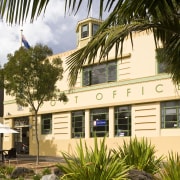Return to splendour
Designed in the Art Deco tradition of the '30s, this former post office building has been restored to its past grandeur with a contemporary interior that offers the best of both worlds

Government buildings document a country's architectural heritage and they can still have a story to tell long after they have been retired from their original function.
In the 1930s, New Zealand government architects were influenced by the prevalent Art Deco architecture, which was seen in the design of post office buildings throughout the country. The Devonport Post Office, built in 1938, typified this architecture, says architect Lloyd Macomber of Salmond Reed Architects.
"The post office is a good example of the strictly classical Art Deco style. Although decoratively restrained, its solid concrete construction, rounded corners, steel-framed windows and strong horizontal banding are all typical features of the Art Deco period."
For many years after the postal services moved out, the building was home to Jackson's Museum a private car museum. In the early '90s, a concrete bunker-style extension was added to the rear. Two years ago the building, which is scheduled with both the NZ Historic Places Trust and North Shore City Council, was bought by Eddie and Sharon de Heer, who could see the property's potential.
"The building had been languishing, unoccupied, for some time and needed an injection of new life and vitality," says Eddie de Heer.
The couple commissioned Salmond Reed Architects, a company with extensive experience in architectural heritage projects, to refurbish the character building and provide retail and food outlets, as well as office and gallery space. Macomber says it was imperative to consult frequently with the NZ Historic Places Trust and the council heritage planner. Advice was also sought from a retail architecture specialist.

"Once the ground rules were established, in respect to what could and couldn't be changed, the refurbishment was relatively straightforward."
The exterior was painted to closely match the original colours. Although clearly not original, a Victorian turret on the roof an expression of architectural preservation by a previous owner was retained.
Macomber says with all non-original interior partitions removed, the building was essentially just the four exterior walls and one solid concrete interior wall that once separated the postmaster's office and post box lobby.
"The beauty of the building is the fact that it is so basic. The solid concrete structural elements are a key part of its appeal. On the interior, the most decorative features are the original plaster ceilings, which were retained, and a terrazzo-tiled floor in the vestibule."
The team was able to restore the original tongue-and-groove kauri floors, however. De Heer says at least five layers of substrate, including old linoleum and vinyl, were removed to reveal the floorboards. New services were able to be installed in a crawl space beneath the floor. Preserving the original tiling was not practical, so tiles closely matching the original hues were laid.
The architect says bringing more light into the rear of the building was a priority. To achieve this, a large opening was cut in the roof of the '90s extension and a modern skylight introduced. This creates a light-filled atrium and stairwell that helps draw people to the rear.
"Consistent throughout the design process was the concept of a double-height glazed box that let in abundant natural light from the roof, which then spilled out into the interior of the building."
A new contemporary staircase to the mezzanine level was built to replace the original stairs. This features jarrah treads, glass balustrading and stainless steel handrails.
"Our architectural practice has no qualms about introducing contemporary elements to historic buildings," Macomber says. "Where possible, we will faithfully match original detailing. But with an empty shell, the rules are relaxed the building simply needs to work and if that means bringing in more light with skylights and glazed walls, then that's the best option.
"The glass walls have no negative impact on the building. On the contrary, they allow you to see through the spaces to appreciate the heritage features. They also provide a light, bright and inviting interior."
Story by: Colleen Hawkes
Home kitchen bathroom commercial design
Walk this way – garden pathways to lead your thinking
From farmhouse to farmstead
Different rooms, same sky-blue ceiling














